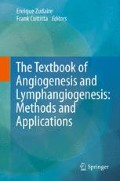Abstract
The chick aortic arch assay represents a major modification of the rat aortic ring assay. Originally developed for the specific purpose of testing thalidomide (which had previously been shown to have limited effects in rodents but strong effects in chick embryos), the assay avoids the use of laboratory animals, is rapid, with an assay time of 1–3days, and can be carried out in serum-free medium. Aortic arches are dissected from day 12–14 chick embryos and cut into rings similar to those of the rat aorta. When the rings are placed on Matrigel, substantial outgrowth of cells occurs within 48h, with the formation of vessel-like structures readily apparent. If the aortic arch is everted before explanting, the time for observing endothelial cell outgrowth can be reduced to 24h. Both growth-stimulating factors, such as VEGF-A or FGF-2, as well as inhibitory substances such as endostatin, can be added to the medium, where their effect becomes easily measured.
Access this chapter
Tax calculation will be finalised at checkout
Purchases are for personal use only
References
Nicosia R, Ottinetti A (1990) Growth of microvessels in serum-free matrix culture of rat aorta. A quantitative assay of angiogenesis in vitro. Lab Invest 63:115–122
Muthukkaruppan V, Shinners B, Lewis R et al (2000) The chick embryo aortic arch assay: a new, rapid quantifiable in vitro method for testing the efficacy of angiogenic and anti-angiogenic factors in a three-dimensional, serum-free organ culture system. Proc Am Assoc Cancer Res 41:65
Auerbach R (2006) An overview of current angiogenesis assays: choice of assay, precautions in interpretation, future requirements. In: Staton C, Lewis C, Bicknell R (eds) Angiogenesis assays. Wiley, Chichester, pp 361–374
Auerbach R (2008) Models for angiogenesis. In: Figg WD, Folkman J (eds) Angiogenesis: an integrative approach from science to medicine. Springer, New York, pp 299–312
Auerbach R, Lewis R, Shinners Bl N et al (2003) Angiogenesis assays: a critical overview. Clin Chem 49:32–40
Akhtar N, Dickerson EB, Auerbach R (2002) The sponge/Matrigel angiogenesis assay. Angiogenesis 5:75–80
Isaacs JS, Jung YJ, Mimnaugh EG, Martinez A et al (2002) Hsp90 regulates a von Hippel Lindau-independent hypoxia-inducible factor-1 alpha-degradative pathway. J Biol Chem 277:29936–29944
Martinez A, Zudaire E, Portal-Nunez S et al (2004) Proadrenomedullin NH2-terminal 20 peptide is a potent angiogenic factor, and its inhibition results in reduction of tumor growth. Cancer Res 64:6489–6494
Wen W, Lu J, Zhang K, Chen S (2008) Grape seed extract inhibits angiogenesis via suppression of the vascular endothelial growth factor receptor signaling pathway. Cancer Prev Res (Phila) 1:554–561
Zhang K, Lu J, Mori T, Smith-Powell L et al (2011) Baicalin increases VEGF expression and angiogenesis by activating the ERR{alpha}/PGC-1{alpha} pathway. Cardiovasc Res 89:426–435
Oh S-H, Kim W-Y, Kim J-H et al (2006) Identification of insulin-like growth factor binding protein-3 as a farnesyl transferase inhibitor SCH55335-induced negative regulator of angiogenesis in head and neck squamous cell carcinoma. Cancer Res 12:653–661
Hamburger V, Hamilton H (1951) A series of normal stages in the development of the chick embryo. J Morphol 88:49–92
Wikipedia (2011) http://en.wikipedia.org/wiki/Hamburger-Hamilton_stages
Folberg R, Hendrix MJ, Maniotis A (2000) Vasculogenic mimicry and tumor angiogenesis. Am J Pathol 156:361–381
Globerson A, Auerbach R (1965) Primary immune reactions in organ cultures. Science 149:991–993
Mishell RI, Dutton RW (1966) Immunization of normal mouse spleen cell suspensions in vitro. Science 153:1004–1006
Acknowledgments
The assay method described in this manuscript was developed with the able participation of B Shinners, R Lewis, S-J Park, B Baechler and L Kubai. We thank Wanda Auerbach for editorial assistance.
Author information
Authors and Affiliations
Corresponding author
Editor information
Editors and Affiliations
Rights and permissions
Copyright information
© 2012 Springer Science+Business Media Dordrecht
About this chapter
Cite this chapter
Auerbach, R., Muthukkaruppan, V. (2012). The Chick Embryo Aortic Arch Assay. In: Zudaire, E., Cuttitta, F. (eds) The Textbook of Angiogenesis and Lymphangiogenesis: Methods and Applications. Springer, Dordrecht. https://doi.org/10.1007/978-94-007-4581-0_8
Download citation
DOI: https://doi.org/10.1007/978-94-007-4581-0_8
Published:
Publisher Name: Springer, Dordrecht
Print ISBN: 978-94-007-4580-3
Online ISBN: 978-94-007-4581-0
eBook Packages: Biomedical and Life SciencesBiomedical and Life Sciences (R0)

